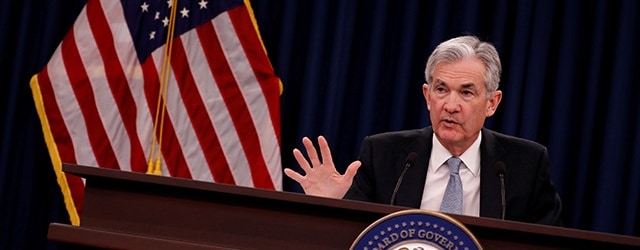Powell has instead called for tax and spending changes to promote growth.

The “gift” of negative interest rates recommended by President Donald Trump to boost US economic growth isn’t part of the Federal Reserve’s monetary policy toolkit. “I know there are fans of the policy, but for now it’s not something we’re considering,” Fed Chairman Jerome Powell said last month, noting that negative rates had mixed results in Europe and Japan.
Not only would negative rates be messy to implement in the US, requiring some laws to be revised, but they also could result in less, rather than more, bank lending at a time when the economy is in dire straits.
“The issue really is a concern over interrupting the intermediation process, reducing bank profitability and thereby reducing the availability of credit in the economy,” Powell said last month in a videoconference sponsored by the Peterson Institute for International Economics. He said the US economic outlook was “highly uncertain and subject to significant downside risks.”
In a May 15 semiannual report on financial stability, the Fed said US banks risk losses related to the Covid-19 pandemic, which could strain their finances as nonperforming loans increase.
Negative rates discourage savings and encourage borrowing. Sweden’s Riksbank, one of the first central banks to introduce negative rates in 2015, ended the policy in December, fearing that companies and consumers were taking on too much debt.
The last time the US Federal Open Market Committee examined the issue of negative rates in detail, in October 2019, all 17 participants agreed that they didn’t appear to be an attractive monetary policy tool, according to minutes of the meeting. And with its heavy reliance on short-term money market funds, the US needs positive interest rates more than other countries, the committee said. Negative rates would “create significant complexity or distortions to the financial system.”
The issue is heating up again at a time when the outlook for inflation is as uncertain as the outlook for economic growth. Recent price indexes have signaled deflation, with the core consumer price index down a record 0.8% in April. Soaring grocery prices were more than offset by sinking oil prices, pushing the headline CPI down 0.45%. Producer prices have fallen even faster.
“The Covid-19 crisis and the policy response to it are disinflationary, and in the next couple of years outright deflation is a bigger risk than serious inflation,” Ethan Harris, global economist at Bank of America Securities, wrote in a BofA Global Research report. Some of the extreme price distortions due to lockdowns should reverse, he said, but the main drivers of disinflationary pressure will remain: unemployment and unused productive capacity.
Powell has called for tax and spending changes to promote growth. “Additional fiscal support could be costly, but worth it if helps avoid long-term economic damage and leaves us with a stronger economy,” he said last month. Powell has no intention “for now” of using negative rates.



